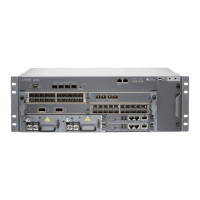The following sample calculation for an 8-km-long single-mode link with a power budget
(P
B
) of 13 dB uses the estimated values from Table 55 on page 80 to calculate link loss
(LL) as the sum of fiber attenuation (8 km @ 0.5 dB/km, or 4 dB) and loss for seven
connectors (0.5 dB per connector, or 3.5 dB). The power margin (P
M
) is calculated as
follows:
P
M
= P
B
– LL
P
M
= 13 dB – 8 km (0.5 dB/km) – 7(0.5 dB)
P
M
= 13 dB – 4 dB – 3.5 dB
P
M
= 5.5 dB
In both examples, the calculated power margin is greater than zero, indicating that the
link has sufficient power for transmission and does not exceed the maximum receiver
input power.
Related
Documentation
Understanding Fiber-Optic Cable Signal Loss, Attenuation, and Dispersion on page 81•
Understanding Fiber-Optic Cable Signal Loss, Attenuation, and Dispersion
This topic describes signal loss, attenuation, and dispersion in fiber-optic cable. For
information about calculating power budget and power margin for fiber-optic cable, see
“Calculating Power Budget and Power Margin for Fiber-Optic Cables” on page 79.
•
Signal Loss in Multimode and Single-Mode Fiber-Optic Cable on page 81
•
Attenuation and Dispersion in Fiber-Optic Cable on page 82
Signal Loss in Multimode and Single-Mode Fiber-Optic Cable
Multimode fiber is large enough in diameter to allow rays of light to reflect internally
(bounce off the walls of the fiber). Interfaces with multimode optics typically use LEDs
as light sources. However, LEDs are not coherent sources. They spray varying wavelengths
of light into the multimode fiber, which reflects the light at different angles. Light rays
travel in jagged lines through a multimode fiber, causing signal dispersion. When light
traveling in the fiber core radiates into the fiber cladding, higher-order mode loss results.
Together these factors limit the transmission distance of multimode fiber compared with
single-mode fiber.
Single-mode fiber is so small in diameter that rays of light can reflect internally through
one layer only. Interfaces with single-mode optics use lasers as light sources. Lasers
generate a single wavelength of light, which travels in a straight line through the
single-mode fiber. Compared with multimode fiber, single-mode fiber has higher
bandwidth and can carry signals for longer distances.
Exceeding the maximum transmission distances can result in significant signal loss, which
causes unreliable transmission.
81Copyright © 2017, Juniper Networks, Inc.
Chapter 8: Transceiver and Cable Specifications

